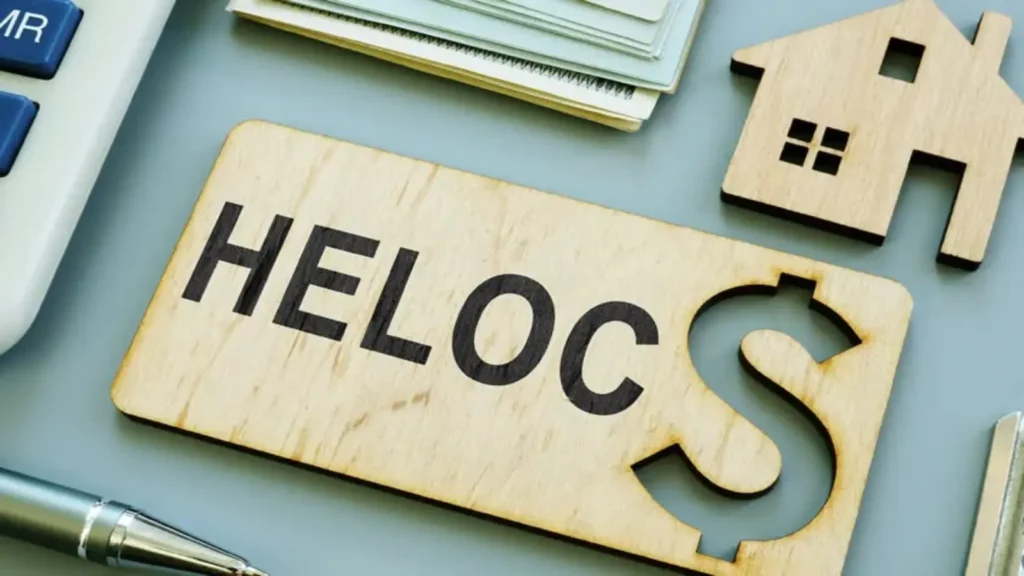Selling a house is a complex and stressful process. Add a Home Equity Line of Credit (HELOC), and the process becomes even more tiring.
While a HELOC provides homeowners with a flexible and accessible source of funds, it also complicates the selling process. If you’re considering selling a house with a HELOC, you’re probably wondering how it works and what you need to do to make it happen.

To help you, we’ll explore the ins and outs of selling a house with a HELOC, including what a HELOC is, how it works, and what happens to it when you sell your home. We’ll also provide tips for navigating this process and discuss the advantages and disadvantages of selling a house with a HELOC.
What Is A HELOC?
If you’re a homeowner looking to access the equity in your home, a HELOC can be a convenient and flexible option.
A revolving line of credit, HELOC, or Home Equity Line of Credit uses your home’s equity as collateral. It’s similar to a credit card in that you can borrow funds up to a specific limit and repay them over time. However, unlike a credit card, a HELOC typically has a much lower interest rate and allows you to borrow a much larger amount of money.
So, how does a HELOC work?
It is pretty simple. All you need to do is apply for a HELOC with a lender. The lender will review your credit score, income, and other financial information to determine whether you qualify for a HELOC and what your credit limit will be. Once approved, you can draw funds up to the credit limit from the HELOC as needed.
Unlike a traditional loan, you’ll only be charged interest on the borrowed money, not the entire credit limit. For example, if your credit limit is $50,000, but you’ve only borrowed $10,000, you’ll only pay interest on the $10,000 you’ve borrowed.
Most HELOCs have a draw period, during which you can borrow funds, and a repayment period, during which you’ll need to repay the borrowed funds. The draw period is usually 5-10 years, while the repayment period can be up to 20 years. During the draw period, you’ll only make interest payments on the borrowed funds, but during the repayment period, you’ll make both principal and interest payments.
Selling A House with A HELOC
Selling a house becomes complicated if you have a HELOC on it. Most of the steps remain the same, such as working with a real estate agent who will assist with negotiations and paperwork, listing your house for sale, and accepting an offer. But what changes is the first and the last step.
If you have a HELOC on your house, the first step is to determine the amount you owe before you can list the home for sale. Contact your lender to figure out the exact amount, and this will help you determine how much you should sell your house for to pay off the HELOC.
And once you sell your house, the last step is to pay off the HELOC. This means the funds from the sale should be used to pay off the outstanding balance on the HELOC. If you owe more on your HELOC than the sale price of your house, you’ll have to find a way to pay off the difference.
It’s crucial that you keep your lender informed of your plans to sell your house so they can ensure that the HELOC is paid off in full. Ensure you communicate with your lender throughout the process to avoid surprises or delays.
What Happens to The Heloc When You Sell Your House?
When you sell your house with a HELOC, the outstanding balance on the HELOC will have to be paid off using the proceeds from the sale. This means the funds from the sale of your house will be used to pay off the HELOC in full before any money is distributed to you as the seller.
Your lender will play a vital role in the process of paying off the HELOC to ensure everything is handled properly. Here’s how it typically works:
Step 1: Once you’ve accepted an offer on your house, you’ll inform your lender that you’re selling the property. Your lender will then provide you with information on the outstanding balance of your HELOC and will work with you to ensure that it’s paid off in full.
Step 2: The funds from the sale of your house will be deposited into an escrow account. An escrow account is a type of account that’s used to hold funds for a specific purpose, such as paying off a HELOC. The escrow account will be managed by a third party, such as a title company or an attorney.
Step 3: Your lender will provide the escrow agent with the payoff amount for your HELOC, which includes the outstanding balance of the HELOC plus any interest, fees, or other charges that may have accrued since your last payment.
Step 4: Once the escrow agent receives the funds from the sale, they’ll use it to pay off the outstanding balance of your HELOC. Your lender will work with the escrow agent to ensure that the HELOC is paid off in full and that there are no outstanding balances or liens on the property.
Step 5: Once the HELOC is paid off, your lender will release the lien on your property. This means you’ll be free to transfer property ownership to the buyer, who will receive a clear title.
Remember that paying off a HELOC is time-consuming, and there might be fees or other charges associated with the process. Your lender will be able to offer you specific information on the costs and timeline for paying off your HELOC.
Tips For Selling a House With A HELOC
Selling a house with a HELOC can be more complicated than selling a home without one. However, there are steps you can take to make sure the process goes smoothly. Here are some tips to keep in mind:
- Work With an Experienced Real Estate Agent: Selling a house with a HELOC involves some extra steps and paperwork. So, it’s essential you work with a real estate agent experienced in this area. They will help you navigate the process and ensure everything is handled properly.
- Price Your Home Appropriately: When selling with a HELOC, you must price your home appropriately. Remember that the outstanding balance on your HELOC will need to be paid off from the sale proceeds. So, you’ll want to ensure you’re not asking for more than the property is worth.
- Consider Paying Off the Heloc Before Selling: If possible, it is worth considering paying off the outstanding balance on your HELOC before putting your house on the market. This will make the selling process go more smoothly and ensure no delays or issues during the sale.
- Be Prepared for Delays: Selling a house with a HELOC can take longer than selling a home without one, so it’s essential to be prepared for potential delays. Ensure you have a contingency plan in place if the sale takes longer than expected.
Selling A House with A HELOC: The Bottom Line
Selling a house with a HELOC can be a bit more complicated than selling one without one. However, having a good understanding of how HELOCs work, what happens to them when you sell your house, and the tips for selling a home with a HELOC can help you navigate the process confidently.
Remember that selling a house with a HELOC has both advantages and disadvantages. While HELOC can provide you with access to funds that you can use to make improvements to your home or pay for other expenses, the outstanding balance on your HELOC must be paid off from the sale proceeds. This can potentially impact your net profit from the sale.
So, weigh these advantages and disadvantages carefully before planning your next move. In addition, consider working with an experienced real estate agent who will help you navigate the process and ensure everything is handled properly.
📞 Have Questions? Ask The Chris Eckert Real Estate Team
Give The Chris Eckert Real Estate Team a call today at 650.627.3799 to learn more about local areas, discuss selling a house, or tour available homes for sale.





